HikVision DVR-Camera Setup
Patriot can connect to HikVision DVR/NVR and/or detached HikVision network cameras.
Prerequisites
- A Patriot License with the Hikvision Module
- The HikVision Client Files (x86 or x64 or both) installed into:
-
The Client Installation Folder of each workstation that will view the Hikvision CCTV.
For x86:
This folder is normally C:\Program Files (x86)\Patriot Systems\Patriot Version 6 Client\
For x64:
This folder is normally (x64) C:\Program Files (x86)\Patriot Systems\Patriot Version 6 Client\CameraViewer\x64
-
The Task Service installation folder for each service that will host a HikVision task.
For x86:
This folder is normally C:\Program Files (x86)\Patriot Systems\Patriot Task Service\
For x64:
N/A
Patriot supports both in-process (x86) and dedicated process (x64) camera viewing selected by the client camera type settings HikVision and HikVision64 respectively. HikVision64 is preferred due to x86 memory restrictions and isolation from other functions of the Patriot client. It is possible to operate a combination of HikVision and HikVision64 clients. Both camera types are supported by the same HikVision task (currently x86 only).
Contact Patriot Support for these files.
Hikvision Client Files Versions
For x86:
- Latest version: 6.1.6.45
- Previous available version: 6.1.4.42
For x64:
- Latest version: 6.1.9.48
- Previous available version: N/A
Setting up the DVR
Full DVR configuration is beyond the scope of this document. In this section DVR or camera settings important to Patriot monitoring are covered only. Please refer to your HikVision DVR manual when configuring a new DVR installation.
Most settings described here as required for connecting Patriot to a DVR installation are identical or very similar when connecting independent HikVision network camera(s).
See also
Record DVR/Camera details
-
DVR/Camera IP Address and SDK Port number (if the device has a public static address), or the DDNS Alias (if using a service like www.hik-online.com).
-
DVR/Camera Username and Password
Configure IP Ports and Firewall
Patriot requires that the DVR or detached camera's SDK Port and RTSP Port are both correctly port forwarded through the external firewall to access media streams over the internet.
Setup Event Reporting
Most alarm events are generated at the camera level and can be configured from the Camera Settings section of your DVR.
Record Schedule
A Record Schedule must be enabled and configured for each camera you intend to use with Patriot for alarm event playback. Note that alarm events will only be reported when the DVR is Armed. (See Remote Arming/Disarming the DVR.)
Pre and post alarm record times are configurable from the Advanced menu.
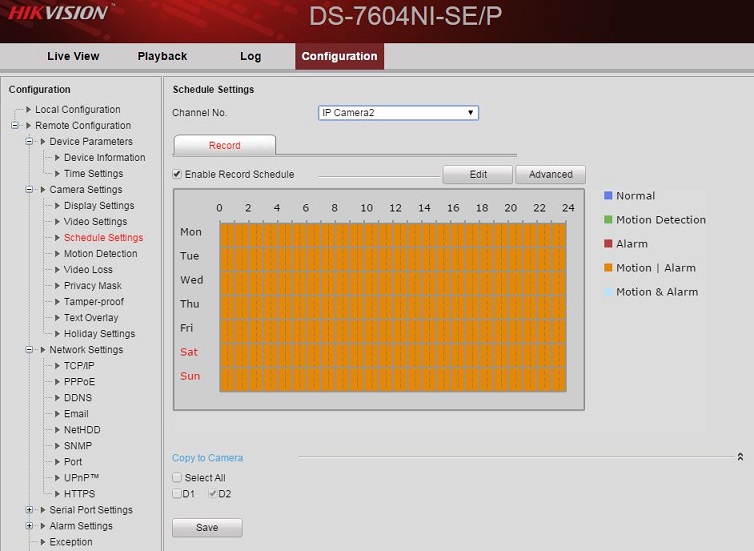
Notify Surveillance Center
Notify Surveillance Center must be enabled on each alarm event type which you intend to be reported to Patriot.
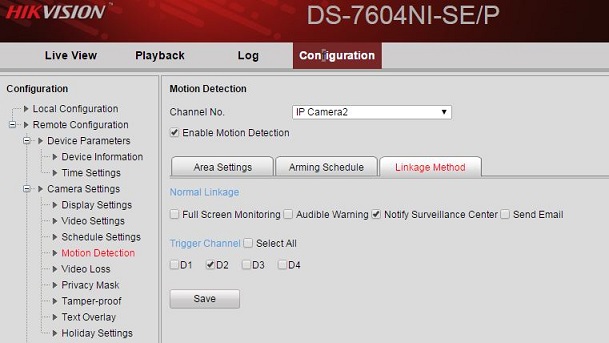
Patriot Client Setup
-
Switch to the Zones Tab of a client.
-
Set the Camera Type option to HikVision or HikVision64.
-
Choose the Task used for event reporting and polling. (see below for task setup details)
-
Choose the Camera Stream used for streaming all camera feeds.
-
Override the Event Reporting setting if different to the task setting (see below).
-
If required, check Poll Camera and choose a polling interval in minutes.
-
If the client has a DVR installed enter the address into the Location field and enter the DVR Login and Password (if required). If the client uses detached network cameras only then leave these fields blank.
-
Select or insert a Zone which will have a camera associated with it and check Camera Enabled.
If the camera is attached to a DVR then ensure Attached To DVR is checked and the zone no. matches the camera number on the DVR.
If the camera is a detached network camera then you may use any unused zone no. but you must enter the camera address into the Location field and enter the camera Login and Password (if required).
Zone Numbers used for cameras must be unique. Do not use the same zone no. twice with a different module no.. This will give unpredictable results.
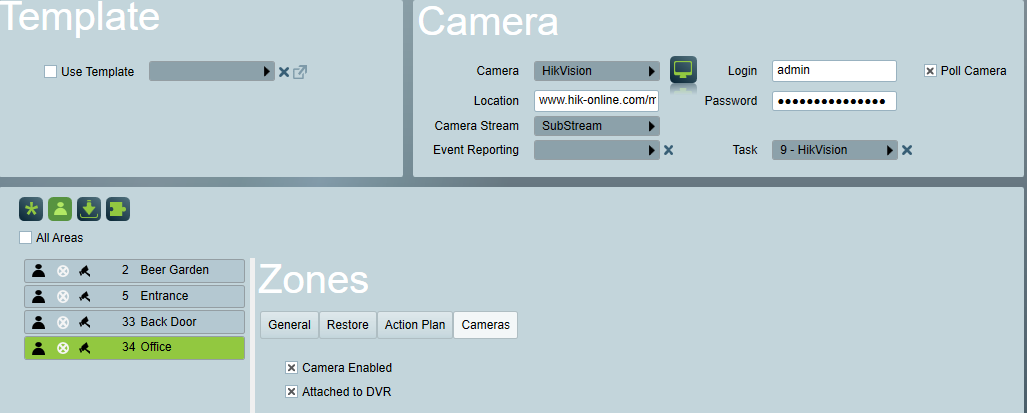
When entering a DVR or camera address into a Location field use one of the following formats:
| Using Default Port (8080) | Custom Port (e.g. 8000) | |
|---|---|---|
| Using static IP Address | 158.123.1.15 | 158.123.1.15:8000 |
| Using domain name | domainname.com | domainname.com:8000 |
| Using a DDNS service such as www.hik-online.com | www.hik-online.com/my-camera | www.my-ddns-service.example.com:8000/my-camera |
Dual Monitoring with an Alarm Panel
If you are monitoring a HikVision DVR site in combination with a standard alarm panel, you will need to setup dual monitoring. In a dual monitoring scenario it is likely that you will get zone conflicts between the alarm panel zone list and the HikVision camera listing. For this reason recommended practice is to setup a separate area account for the camera system. See the Dual Monitoring section of DVR monitoring for more details.
Remote Controlling the DVR
Patriot currently supports two remote action command types (available from both the Patriot Windows Client and Web Client) for remote control of HikVision devices:
- Arm/Disarm lets you remotely arm or disarm the device.
- Set Output lets you remotely set or unset an analogue or IP output on the device. Available device output information can be retrieved from the Info. button on the Cameras tab. Note that Patriot does not currently support setting outputs on attached devices e.g. if you have Patriot connected to a HikVision DVR then you can only set outputs located on that DVR - you cannot set outputs located on cameras attached to the DVR.
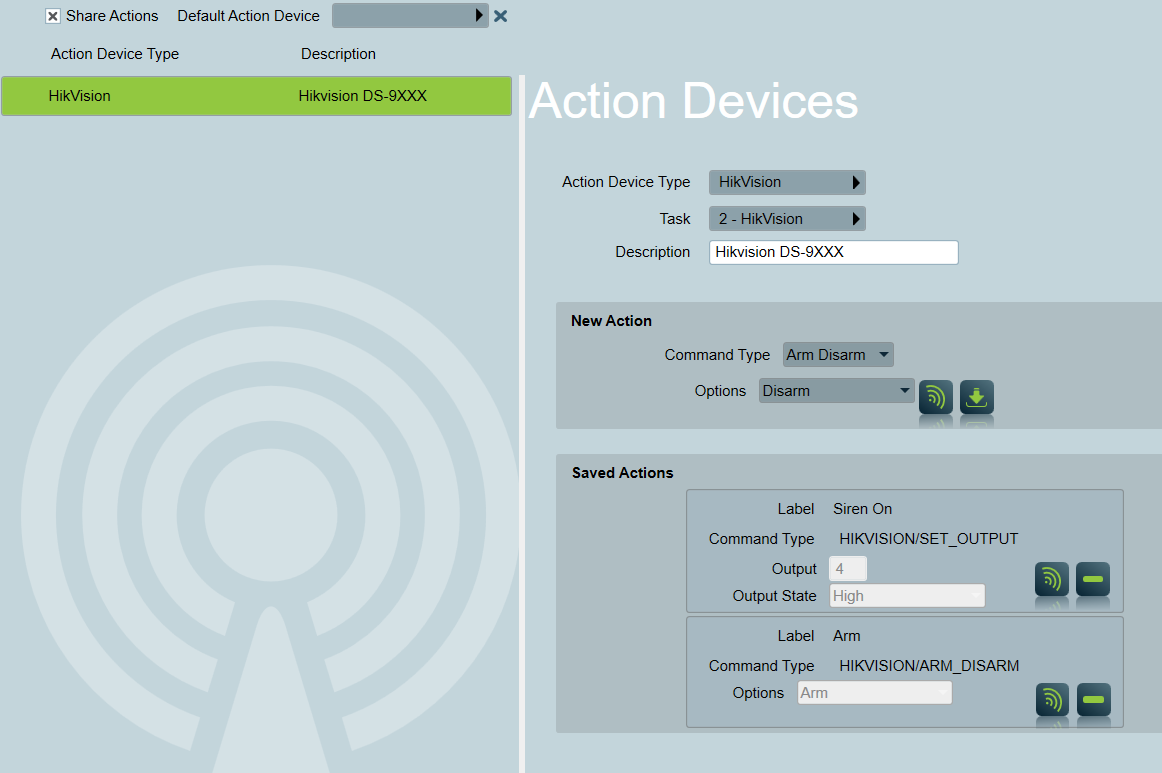
Remote action commands for arming and disarming the DVR will only work for sites configured with Arm On Status Event Reporting.
Automatic Remote Arming/Disarming the DVR
HikVision devices which have alarm event reporting enabled are not normally configured using schedules within the device (frequent changes in the schedules often make this impractical). For this reason Patriot includes an automatic remote Arming/Disarming feature (additional to the manual Arm/Disarm action command) which is designed to work in dual monitoring scenarios.
View the Remote Arming/Disarming a DVR document for further details.
Camera Audio and Sound
To capture and receive audio for voice broadcast you must have a microphone device connected to your PC.
HikVision Task Setup
Multiple HikVision tasks can be created. Each Patriot client indicates which task is responsible for handling the client. Splitting clients across multiple tasks will help performance when monitoring large numbers of HikVision clients or receiving large numbers of events.
Each HikVision receiver task will only log alarm events to Patriot clients that have been configured and remotely armed as detailed in the previous section. Clients that have Set (Closed) status at the time of Task start up are automatically armed by the HikVision task.
Task Setup
Please read the Task Settings document for general information about adding tasks.
Add a new task to the list in the Task Settings window. Double click on HikVision in the drop down list in the details area of the window.
Click the next button to continue. The HikVision task settings form will appear.
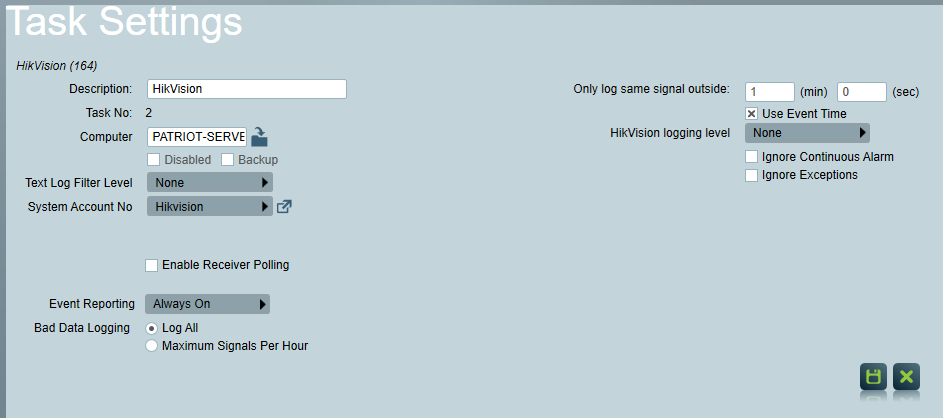
Task Settings
-
Only Log Same Signal outside: This setting prevents repeated signals from cluttering the signal history. This is useful if a DVR sends the same signal repeatedly -- movement on cameras can generate a lot of motion detection events, for example. You can set the number higher to reduce the amount of duplicated signals. When monitoring for Motion Detection, a setting above 1 minute is recommended.
-
Use Event Time:
If enabled, Patriot will use the time an event is received to locate the event video clip. This is the default and recommended behaviour as it works well regardless of whether your Hikvision devices are configured for continuous or event driven video recording. If this option is disabled Patriot will return to its legacy behaviour for finding event clips: the newest video clip after the event was received is selected. This behaviour is not recommended because it does not work well with Hikvision devices in continuous recording mode, and it is known to lead to performance problems when the system is under high load with many devices sending events simultaneously.
-
Enable Receiver Polling: This setting can be used as an extra protection against Hikvision task stopping to process alarms. When enabled, the Receiver Timeout setting can be entered. If the task fails to process a message, e.g. an alarm or exception message, within the Receiver Timeout setting, a Polling Failure (65003) signal will be logged to the task's system account.
-
Event Reporting: Defines the default behaviour of connected DVR's regarding event reporting. This setting should be set to the behaviour you require for the majority of sites being monitored through this task. The option can be overridden on a per site basis (within the Patriot client) if required. Three options are available:
- Always On: for sites that should always report events.
- Armed On Status: for sites which should only report when the site is armed.
- Always Off: for sites that should never report events. This will help speed up the startup and shutdown time of the task.
On task startup, Patriot will connect to each matching HikVision DVR that you have configured in the Zones Tab of Patriot clients, and it will start receiving alarms from the clients (dependent on Event reporting setting in task and individual clients).
- Ignore Exceptions: This setting can be used to turn off the logging of signals which record exceptions (event type 10,000+) where reported from the HikVision SDK. This should only be enabled if there are an excessive number of these signals being reported. Please ensure you report cases where large number of exceptions are being logged to Patriot support.
- Ignore Continuous Alarm: This setting can be used to ignore Continuous Alarm Events (event type 244). These event types generally are not required to be sent to the monitoring station. Some DVR's can be configured to disable these in the DVR, which is the preferred method as it prevents additional load being placed on the HikVision SDK. Where this isn't possible, this task option can be used to avoid logging the events as signals.
Polling
When Poll Camera option is enabled in the client camera settings, the HikVision task will periodically check the DVR, and will log a polling failure signal to the client if the DVR connection is disrupted. A poll restore signal will be logged when the connection restores.
Operation: Using the Cameras
You can view Cameras from different screens within Patriot
- The camera can be viewed directly by clicking on the camera icon next to the zone, in the zone list.
- When responding to an activation from the client, a video event must have recently reported before this activation is treated as a video verification alarm. A video event is defined as an event reported from the DVR where video access makes sense (like a Motion Detection event, or the Input on the Camera has triggered). Some events from the DVR (generally system fault events) are not reported as video events. The source of the signal received generally indicates if the event is a video event or not. The video event must have reported within the time specified in the Time Range For Video Event setting (System Settings > System Wide Settings > Misc Settings > Camera Video Settings), from the time of the activation to be treated as a recent event. A Video Verification Alarm will display the Camera Button on the Activation tab (if multi screen support is enabled, the camera controls will be displayed immediately), clicking on the Camera button will take the operator directly to the camera associated with the Zone which has originated the activation. If multiple video events have recently been received, these will all be displayed on the camera window.
- As motion detection alarms from the DVR isn't always reliable, using the alarm events from the dual monitored alarm panel can reduce false alarms. The recommended approach to setting this up is to configure the alarm events from the alarm panel to generate alarms in Patriot (ie priority action plan). Then configure the motion detection events from the DVR with non priority action plans. In this way a single motion detection event won't generate an alarm to the operator, but an alarm event from the panel and the DVR together, will generate an activation for the operator, and it will be treated as a video verification alarm.
- Cameras can be viewed in the Maintain Client Window under the Cameras Tab
- Playback of historic alarm events is possible from the Signal History area of the Patriot client file.
Operational Functions
- When responding to an activation, the camera display will be automatically put into Event view. The first connection shows the alarm event (beginning 10 seconds before the alarm) for the activated zone. The alarm event footage can be replayed easily by clicking on the play from time button. The second connection shows the live feed from the activated zone.
- When using the camera controls in anything other than single view (i.e. quad, nine etc), the camera controls on the left hand tool bar apply to the selected connection. The selected connection has a green border around it. You can change the selected connection by clicking on another connection. The camera control buttons will only be enabled if a camera (from the camera list) has been selected.
- A list of installed camera numbers can be requested from the site by clicking on the info button, from in the Clients Camera tab.
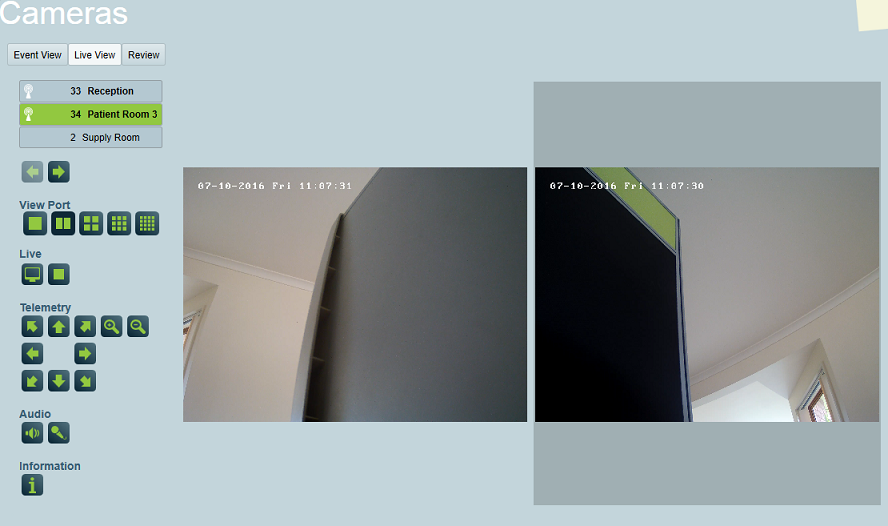
Show Camera Thermal Overlays
Camera Configuration
The camera needs to support thermal features.
- Login the camera via web browser. Use Internet Explorer because some of the settings are not available on other browsers.
- Go to Configuration > Temperature Screening > Basic Settings.
Tick the following two options:
- Enable Temperature Measurement: The main switch of Temperature Screening function.
- Display Temperature Info. on Stream : Overlay Temperature Info on stream, if not ticked, users cannot see the info in recorded videos.
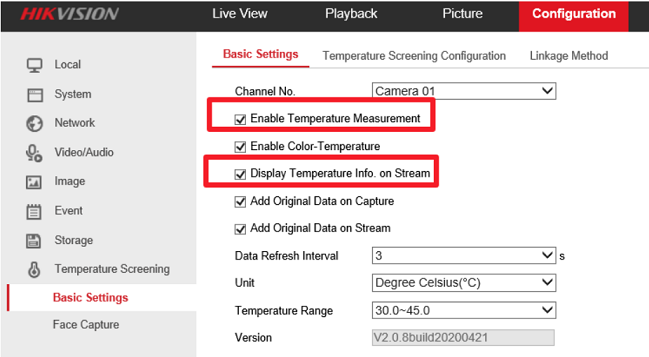
For more details of configuring temperature screening camera, please refer to the HikVision user manual.
Patriot Configuration
In the Patriot Data Service installation directory (typically C:\Program Files (x86)\Patriot Systems\Patriot Data Service\) find the file AppSettings.json. Take a backup of this file, then edit the file using a text editor. You will usually need to run the text editor as administrator.
Add the following setting if it is missing, otherwise set the value:
{
"DataService":{
"Flags": {
"HikvisionThermalEnabled": true,
}
}
}
Save and close the .config file. The Data Service needs to be restarted for the new configuration to take effect.
Trouble Shooting
As a rule of thumb, first check if your client files are on the latest version. Find HCNetSDK.dll in the client files, right click on it and select Properties. You can find the File version in the Details tab. if it is not the latest, try the latest client files and see if it resolves the problem. Newer versions usually have better support for newer device models.
Camera feed doesn't show drawing lines of smart events
This happens on some new models due to the compatibility with the client files. The workaround is to enable stream rule in the NVR's settings.
Login the NVR or camera via web browser. Use Internet Explorer because some of the settings are not available on other browsers. Select Configuration > System > System Settings > metadata Settings, and tick the option Enable Stream Rule. If Sub-stream is selected as the Stream Type, you will need to select Substream as the Camera Stream in Patriot Zones > Camera settings.
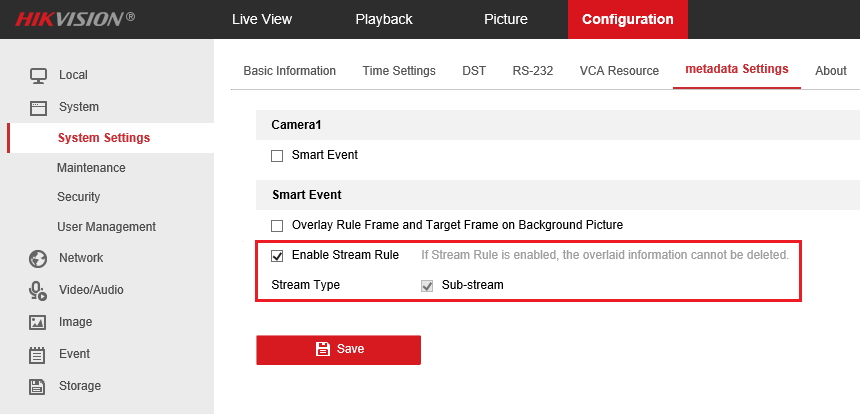
Fail to find event clips Error
This happens when trying to view an event clip from Activation or Signal History. Login the DVR or Camera and check the setting for recording storage schedule. Make sure to set it to Continuous.